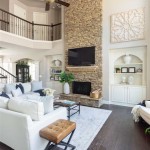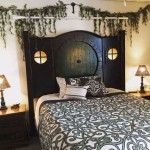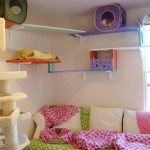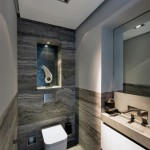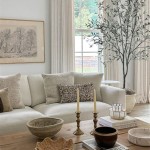Victorian Home Decorating Ideas
The Victorian era, spanning from 1837 to 1901, offers a rich tapestry of design influences. Victorian home decor is characterized by opulence, detail, and a celebration of craftsmanship. Recreating this aesthetic in a modern context requires understanding the key elements that defined the period and knowing how to adapt them to contemporary lifestyles.
Victorian decorating embraced a maximalist approach, rejecting the bare walls and minimalist tendencies that would later emerge. Every surface was considered an opportunity for embellishment, from intricate wallpaper patterns to elaborate furniture carvings. The goal was to create a space that was both comfortable and aesthetically stimulating, reflecting the prosperity and cultural interests of its inhabitants.
Color palettes in Victorian homes were typically rich and saturated. Deep reds, greens, blues, and browns were favored, often used together in complex and layered schemes. These colors created a sense of warmth and intimacy, particularly important in the drafty homes of the period. Textiles played a crucial role, adding texture and pattern to the overall design. Velvet, brocade, and damask were common choices for upholstery and window treatments.
Lighting was another significant element. While gas lighting was prevalent, it was often supplemented with candles and oil lamps to create a soft, ambient glow. Fixtures were typically ornate, featuring elaborate metalwork and glass shades. Mirrors were strategically placed to reflect light and enhance the sense of space.
Embracing Rich Colors and Textures
Color played an integral role in Victorian interior design, often acting as a direct reflection of wealth and social standing. Deeper, more saturated hues were favored over lighter, pastel shades. Burgundy, forest green, navy blue, and chocolate brown were staples. These colors were often paired with contrasting trim in lighter shades like cream or ivory to accentuate architectural details.
To incorporate this into a modern home, begin by identifying a color scheme that resonates with personal taste while staying true to the Victorian aesthetic. One approach is to select a dominant color for the walls and then introduce complementary colors through furniture, textiles, and accessories. For instance, a dining room with deep burgundy walls could be paired with dark wood furniture and gold-toned accents.
Wallpaper was another essential element of Victorian decor. Intricate patterns, such as floral motifs, damasks, and geometric designs, were highly popular. These patterns were often embossed or textured to add another layer of visual interest. When selecting wallpaper, consider the scale of the room and the overall aesthetic. A large, ornate pattern can be overwhelming in a small space, while a smaller, more subtle pattern may be better suited.
Textiles were just as important as color and pattern in creating a luxurious and inviting atmosphere. Fabrics like velvet, silk, brocade, and damask were commonly used for upholstery, curtains, and cushions. These materials added a sense of texture and depth to the room. Layering different fabrics and patterns was also a key element of Victorian design. For example, a velvet sofa could be adorned with cushions in different patterns and textures, creating a visually rich and tactile experience.
Consider incorporating elements like fringed lampshades, tasseled curtains, and embroidered throws to further enhance the Victorian feel. These details add a touch of elegance and sophistication to the space, reflecting the attention to detail that was characteristic of the era.
The use of rugs was also important. Orientals and Axminsters were popular choices, adding warmth and visual interest to the floors. These rugs often featured intricate patterns and rich colors, complementing the overall color scheme of the room. When choosing a rug, consider the size and shape of the room, as well as the style of the furniture. A large rug can help to anchor the space and create a sense of unity, while a smaller rug can be used to define a specific area, such as a seating area or a dining area.
Incorporating Victorian Furniture and Accessories
Victorian furniture is characterized by its ornate carvings, curved lines, and use of rich materials like mahogany and rosewood. Furniture pieces were often heavily decorated with intricate details, reflecting the craftsmanship of the period. Sofas, chairs, and tables typically featured plush upholstery and elaborate embellishments. When selecting furniture for a Victorian-inspired home, it is crucial to choose pieces that reflect these characteristics.
Antique furniture can be a great way to achieve an authentic Victorian look. However, antique pieces can be expensive and may require restoration. Another option is to purchase reproduction furniture, which is designed to replicate the style of the Victorian era. These pieces are often more affordable than antiques and can be a good option for those on a budget. Regardless of whether one chooses antiques or reproductions, it is important to select pieces that are well-made and that fit the overall aesthetic of the room.
Accessories played a vital role in Victorian decor. Mirrors, paintings, sculptures, and decorative objects were used to add personality and visual interest to the space. Mirrors were often placed above fireplaces or in hallways to reflect light and create a sense of spaciousness. Paintings typically depicted landscapes, portraits, or historical scenes, reflecting the cultural interests of the time. Sculptures, often made of marble or bronze, added a touch of elegance and sophistication.
Collectibles were also popular during the Victorian era. Items such as porcelain figurines, antique books, and decorative boxes were often displayed on shelves, tables, and mantels. These collectibles added a personal touch to the space and reflected the owner's interests and hobbies. When incorporating accessories into a Victorian-inspired home, it is important to curate a collection of items that are both visually appealing and meaningful.
Lighting fixtures were another important accessory in Victorian homes. Chandeliers, sconces, and table lamps were used to create a warm and inviting atmosphere. These fixtures often featured ornate metalwork and glass shades, reflecting the craftsmanship of the period. Gas lighting was common, but it was often supplemented with candles and oil lamps. When choosing lighting fixtures, it is important to select pieces that are appropriate for the size and style of the room. A large chandelier may be suitable for a grand dining room, while a smaller sconce may be better suited for a hallway or bedroom.
Floral arrangements were also a key element of Victorian decor. Flowers were used to add color and fragrance to the space, and they were often arranged in elaborate displays. Roses, lilies, and orchids were popular choices. These arrangements were often placed on tables, mantels, and windowsills. When creating floral arrangements for a Victorian-inspired home, it is important to choose flowers that are appropriate for the season and that complement the overall color scheme of the room.
Architectural Details and Finishing Touches
Victorian architecture is characterized by its ornate details, such as high ceilings, elaborate moldings, and bay windows. These architectural elements played a crucial role in shaping the overall aesthetic of the home. While not all homes possess these original features, there are ways to incorporate Victorian architectural details into a modern space.
Adding moldings and trim is a relatively simple and effective way to enhance the architectural character of a room. Crown molding, baseboards, and door and window casings can be used to create a sense of elegance and sophistication. These moldings can be painted or stained to match the overall color scheme of the room. When selecting moldings, it is important to choose styles that are appropriate for the age and style of the house. More elaborate moldings may be suitable for a Victorian-era home, while simpler moldings may be better suited for a more modern space.
Fireplaces were a central feature of Victorian homes, providing warmth and a focal point for the room. Original fireplaces often featured ornate mantels and decorative tiles. If the home has an original fireplace, it is important to preserve and restore it. If the home does not have an original fireplace, it may be possible to install a reproduction fireplace. When selecting a fireplace, it is important to choose a style that is appropriate for the size and style of the room. A large, ornate fireplace may be suitable for a grand living room, while a smaller, simpler fireplace may be better suited for a bedroom or study.
Window treatments were also an important element of Victorian decor. Heavy drapes, curtains, and valances were used to create a sense of privacy and to block out drafts. These window treatments were often made of luxurious fabrics like velvet, silk, and brocade. When selecting window treatments, it is important to choose styles that complement the overall aesthetic of the room. Heavier drapes may be suitable for a formal living room or dining room, while lighter curtains may be better suited for a bedroom or kitchen.
Flooring was another important consideration in Victorian homes. Hardwood floors were common, often covered with rugs or carpets. These were often patterned. Recreating this requires consideration of both practical and aesthetic elements. Consider installing hardwood floors or using patterned tiles to evoke a Victorian atmosphere.
Finally, the finishing touches are what bring a Victorian-inspired home to life. These details include items such as antique mirrors, porcelain figurines, and framed artwork. These items add personality and character to the space, reflecting the individual tastes and interests of the homeowner. When selecting finishing touches, it is important to choose items that are both visually appealing and meaningful. These details should complement the overall aesthetic of the room and create a sense of harmony and balance. Consider carefully selecting framed artwork, lighting, and other smaller accessories to create a cohesive and aesthetically pleasing Victorian-inspired space.

5 Modern Decorating Ideas From A Renovated Victorian House Goodhomes
:max_bytes(150000):strip_icc()/ScreenShot2021-08-18at3.46.48PM-0881e8625a754c1a94a611f3e74a6226.png?strip=all)
27 Modern Victorian Decorating Ideas That Aren T Stuffy
:max_bytes(150000):strip_icc()/alaina-kaczmarski-home-living-1-9b10209fb438487789b81418ed595c2c.jpg?strip=all)
How To Do Victorian Interior Decor The Sophisticated Way

Modern Victorian Decorating Ideas Cb2 Idea Central

Victorian Interior Design Style History And How To Create A Modern Decorator New Jersey

Victorian Living Room Ideas Soho Blog

Ideas To Keep Your Victorian Home Decor Looking Fresh Ovolo London Plaster Moulding Specialists

Feast For The Senses 25 Vivacious Victorian Living Rooms Decoist

7 Victorian Decor Ideas To Keep Your Home Fresh Leader Floors Blog

Victorian Interior Design Style History And How To Create A Modern Decorator New Jersey
Related Posts

